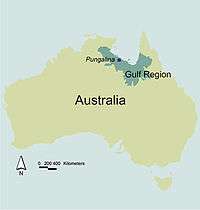Pungalina-Seven Emu Sanctuary
| Pungalina-Seven Emu | |
|---|---|
| Type | Private nature reserve |
| Location | Gulf Country, Northern Territory, Australia |
| Coordinates | 16°43′17″S 137°24′57″E / 16.72139°S 137.41583°ECoordinates: 16°43′17″S 137°24′57″E / 16.72139°S 137.41583°E |
| Area | 3060 km2 |
| Created | 2009 |
| Operated by | Australian Wildlife Conservancy |
| Website | AWC |
Pungalina-Seven Emu Sanctuary is a 3060 km2 nature reserve in the Northern Territory of Australia. It is managed by the Australian Wildlife Conservancy (AWC) which purchased Pungalina Station in 2009, with some assistance from the Wildlife Australia Fund. It adjoins the Gulf of Carpentaria near the border with Queensland, lying in the Gulf Coastal bioregion. The reserve is bordered by Calvert Hills and Wollogorang Stations to the south and east. The nearest town is Borroloola, 150 km to the west.[1]
History
The reserve is made up of two separate pastoral properties, Pungalina and Seven Emu. Pungalina is a former cattle station while Seven Emu is owned by a Garawa man, Frank Shadforth, who has subleased 110,000 ha of the property to AWC for wildlife conservation. Seven Emu has 55 km of coastline and links Pungalina to the coast. The arrangement is a historic partnership between a non-profit, private conservation organization and an indigenous landholder.[2]
Landscape and ecosystems
The Gulf Coastal bioregion is characterised by:
"...gently undulating coastal plains along the southern Gulf of Carpentaria from near the Roper River to near the Queensland border, with scattered rugged areas of Proterozoic sandstones. Soils are predominantly sandy red earths and shallow gravelly sands. The climate is tropical with annual rainfall between 800 and 1200 mm, falling mostly between December and March; cyclones are a frequent phenomenon. The bioregion encompasses the lower reaches of many major rivers. Eucalyptus woodland with tussock or hummock grass understorey dominates the bioregion, with significant areas of tidal flats, mangroves and littoral grassland."[3]
The reserve contains a variety of habitat types including, from south to north, eucalypt woodlands on sandstone plateaus with pockets of dry rainforest in deep gorges, floodplain woodlands and freshwater wetlands, coastal monsoon rainforest, littoral saline grasslands, mangroves, and intertidal mudflats. There is an abrupt transition, marked by an escarpment, between the plateau and the floodplain. The Calvert River drains the dissected plateau country through a network of steep-sided gorges and flows north-eastwards through the lowlands of the reserve before emptying into the Gulf of Carpentaria.[1]


Fauna
An initial faunal survey in 2009 found over 231 vertebrate species present, including 19 native mammals, 151 birds and 61 kinds of reptiles and frogs, representing more than half of the nearly 430 native species that are predicted to occur on the reserve. Animals listed as threatened include the masked owl, red goshawk, Gouldian finch, Carpentarian false antechinus, freshwater sawfish, Mertens' water monitor and Gulf snapping turtle.[1] Other birds and mammals recorded include the purple-crowned fairy-wren, Australian bustard, short-eared rock-wallaby, spectacled hare-wallaby and northern brown bandicoot. Marine species recorded off the beach include Indo-Pacific humpback dolphin, loggerhead turtle, green turtle, shovelnose shark and giant trevally, as well as saltwater crocodiles.[4][5]
The coastal and subcoastal habitats of the southern Gulf region are not as well known ornithologically as the Top End to the west and the Cape York Peninsula to the east, with several birds having gaps in their recorded ranges between the two areas. Birds recorded in the reserve during the survey that help fill the distributional gaps include the Pacific baza, little bronze-cuckoo, figbird and white-breasted whistler.[5]
References
- 1 2 3 AWC: Pungalina property profile
- ↑ AWC: Historic partnership
- ↑ Baker, Bryan; Price, Owen; Woinarski, John; Gold, Stuart; Connors, Greg; Fisher, Alaric & Hempel, Craig (July 2005). Northern Territory Bioregions - assessment of key biodiversity values and threats. Darwin: Northern Territory Department of Natural Resources, Environment and the Arts. p. 87.
- ↑ AWC: Pungalina wildlife
- 1 2 Anon (2009). "Pungalina-Seven Emu" (PDF). Wildlife Matters (Spring 2009): 6–10.
External links
